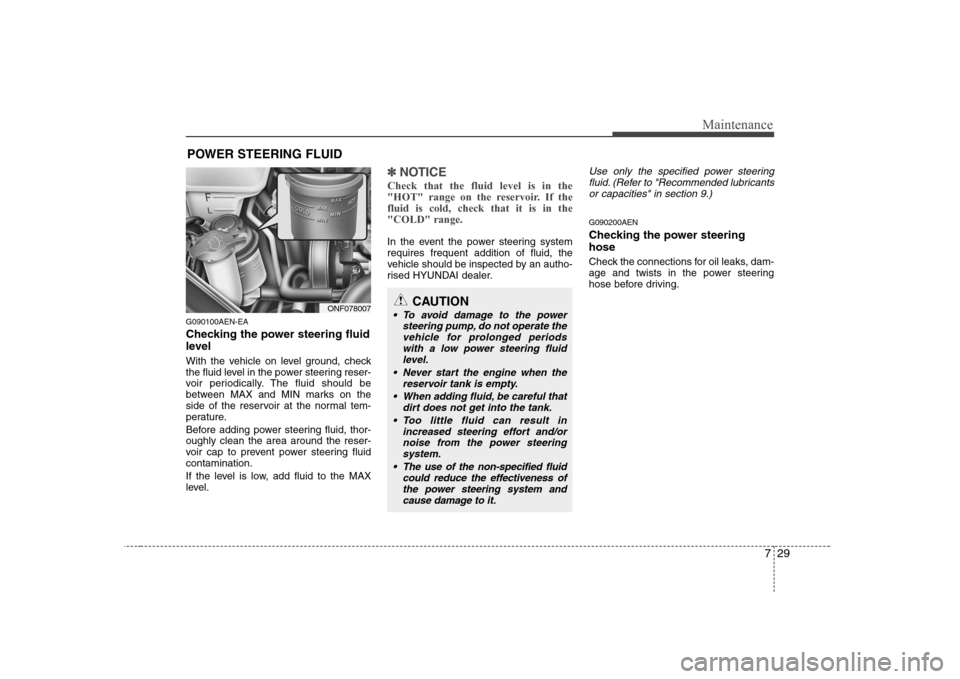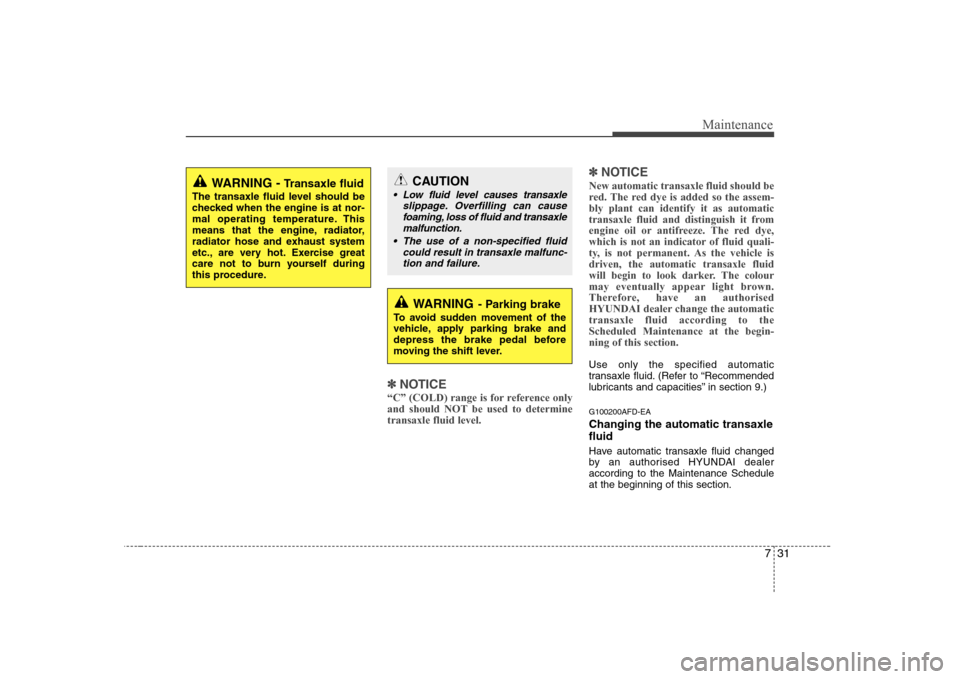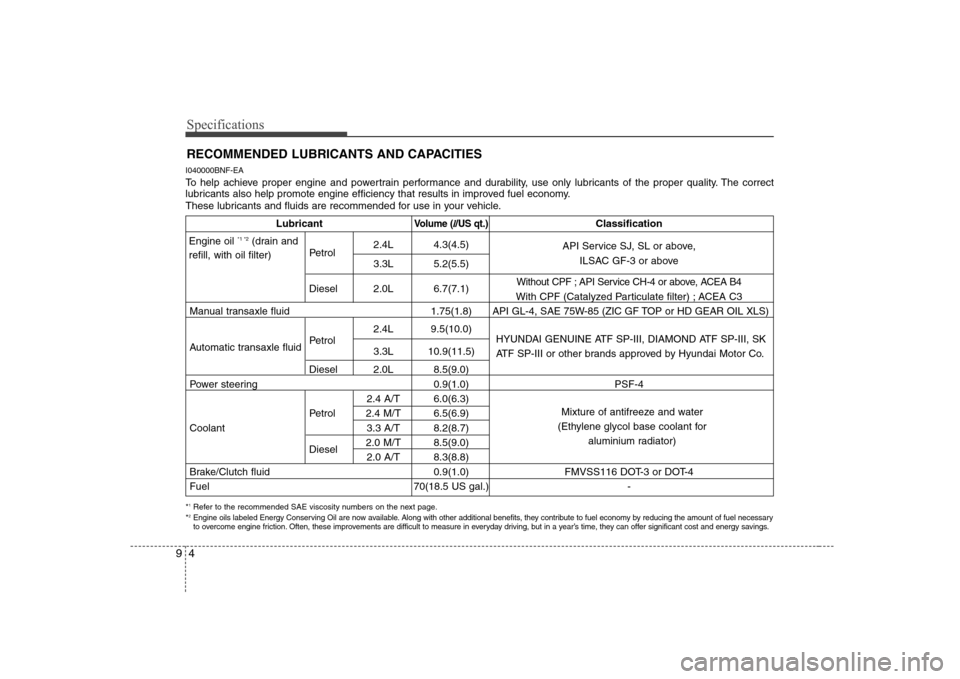Page 271 of 340

Maintenance
28
7
BRAKE AND CLUTCH (IF EQUIPPED) FLUID
G080100AFD-EA
Checking the brake/clutch fluid
level
Check the fluid level in the reservoir peri-
odically. The fluid level should be
between MAX and MIN marks on the
side of the reservoir. Before removing the reservoir cap and
adding brake/clutch fluid, clean the area
around the reservoir cap thoroughly to
prevent brake/clutch fluid contamination.
If the level is low, add fluid to the MAX
level. The level will fall with accumulated
mileage. This is a normal condition asso-
ciated with the wear of the brake linings.
If the fluid level is excessively low, have
the brake system checked by an autho-
rised HYUNDAI dealer.
Use only the specified brake/clutch fluid.
(Refer to “Recommended lubricants andcapacities” in section 9.)
Never mix different types of fluid.
WARNING - Brake fluid
When changing and adding
brake/clutch fluid, handle it careful-
ly. Do not let it come in contact with
your eyes. If brake/clutch fluid
should come in contact with your
eyes, immediately flush them with a
large quantity of fresh tap water.
Have your eyes examined by a doc-
tor as soon as possible.
WARNING - Loss of brake fluid
In the event the brake system
requires frequent additions of fluid,
the vehicle should be inspected by
an authorised HYUNDAI dealer.
CAUTION
Do not allow brake/clutch fluid to contact the vehicle's body paint, as paint damage will result.
Brake/clutch fluid, which has been exposed to open air for an extendedtime should never be used as itsquality cannot be guaranteed. It should be disposed of properly.
Don't put in the wrong kind of fluid.A few drops of mineral-based oil, such as engine oil, in your brakeclutch system can damage brake
clutch system parts.
G120E02TG-D
Page 272 of 340

729
Maintenance
POWER STEERING FLUID
G090100AEN-EA
Checking the power steering fluid
level
With the vehicle on level ground, check
the fluid level in the power steering reser-
voir periodically. The fluid should be
between MAX and MIN marks on the
side of the reservoir at the normal tem-
perature.
Before adding power steering fluid, thor- oughly clean the area around the reser-
voir cap to prevent power steering fluidcontamination.
If the level is low, add fluid to the MAX
level.
✽✽ NOTICE
Check that the fluid level is in the
"HOT" range on the reservoir. If thefluid is cold, check that it is in the"COLD" range.
In the event the power steering system requires frequent addition of fluid, the
vehicle should be inspected by an autho-
rised HYUNDAI dealer.
Use only the specified power steering fluid. (Refer to "Recommended lubricants or capacities" in section 9.)
G090200AEN
Checking the power steering hose
Check the connections for oil leaks, dam-
age and twists in the power steering
hose before driving.
CAUTION
To avoid damage to the power steering pump, do not operate thevehicle for prolonged periods
with a low power steering fluidlevel.
Never start the engine when the reservoir tank is empty.
When adding fluid, be careful that dirt does not get into the tank.
Too little fluid can result in increased steering effort and/ornoise from the power steering system.
The use of the non-specified fluid could reduce the effectiveness ofthe power steering system and cause damage to it.ONF078007
Page 274 of 340

731
Maintenance
✽✽NOTICE
“C” (COLD) range is for reference only
and should NOT be used to determinetransaxle fluid level. ✽
✽
NOTICE
New automatic transaxle fluid should be
red. The red dye is added so the assem-bly plant can identify it as automatic
transaxle fluid and distinguish it from
engine oil or antifreeze. The red dye,
which is not an indicator of fluid quali-
ty, is not permanent. As the vehicle isdriven, the automatic transaxle fluid
will begin to look darker. The colour
may eventually appear light brown.
Therefore, have an authorised
HYUNDAI dealer change the automatictransaxle fluid according to theScheduled Maintenance at the begin-ning of this section.
Use only the specified automatic
transaxle fluid. (Refer to “Recommended
lubricants and capacities” in section 9.) G100200AFD-EA Changing the automatic transaxle fluid
Have automatic transaxle fluid changed
by an authorised HYUNDAI dealeraccording to the Maintenance Scheduleat the beginning of this section.
WARNING - Transaxle fluid
The transaxle fluid level should be
checked when the engine is at nor-
mal operating temperature. This
means that the engine, radiator,
radiator hose and exhaust system
etc., are very hot. Exercise great
care not to burn yourself during
this procedure.
WARNING - Parking brake
To avoid sudden movement of the
vehicle, apply parking brake and
depress the brake pedal before
moving the shift lever.
CAUTION
Low fluid level causes transaxle slippage. Overfilling can causefoaming, loss of fluid and transaxle malfunction.
The use of a non-specified fluid could result in transaxle malfunc-tion and failure.
Page 328 of 340

Specifications
4
9
RECOMMENDED LUBRICANTS AND CAPACITIES
I040000BNF-EA
To help achieve proper engine and powertrain performance and durability, use only lubricants of the proper quality. The correct
lubricants also help promote engine efficiency that results in improved fuel economy.
These lubricants and fluids are recommended for use in your vehicle.
LubricantVolume ( l/US qt.)Classification
API Service SJ, SL or above,
Petrol 2.4L 4.3(4.5)
ILSAC GF-3 or above
3.3L 5.2(5.5)
Diesel 2.0L 6.7(7.1)
Without CPF ; API Service CH-4 or above, ACEA B4
With CPF (Catalyzed Particulate filter) ; ACEA C3
Manual transaxle fluid 1.75(1.8) API GL-4, SAE 75W-85 (ZIC GF TOP or HD GEAR OIL XLS)
Automatic transaxle fluid Petrol2.4L 9.5(10.0)
3.3L 10.9(11.5)
Diesel 2.0L 8.5(9.0)
Power steering 0.9(1.0) PSF-4
2.4 A/T 6.0(6.3)
Petrol 2.4 M/T 6.5(6.9)
Coolant 3.3 A/T 8.2(8.7)
Diesel2.0 M/T 8.5(9.0)
2.0 A/T 8.3(8.8)
Brake/Clutch fluid 0.9(1.0) FMVSS116 DOT-3 or DOT-4 Fuel 70(18.5 US gal.) -
Engine oil *1 *2
(drain and
refill, with oil filter)
HYUNDAI GENUINE ATF SP-III, DIAMOND ATF SP-III, SK
ATF SP-III or other brands approved by Hyundai Motor Co.
Mixture of antifreeze and water
(Ethylene glycol base coolant for aluminium radiator)
* 1
Refer to the recommended SAE viscosity numbers on the next page.
* 2
Engine oils labeled Energy Conserving Oil are now available. Along with other additional benefits, they contribute to fuel econo
my by reducing the amount of fuel necessary
to overcome engine friction. Often, these improvements are difficult to measure in everyday driving, but in a year’s time, they can offer significant cost and energy savings.